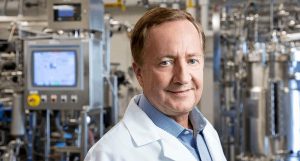Valrox, Potential Hemophilia A Gene Therapy, May Cost Up to $3 Million, BioMarin Says

BioMarin is considering pricing its hemophilia A gene therapy Valrox (valoctocogene roxaparvovec), should it be approved, at $2 million to $3 million.
That range would make Valrox the world’s most expensive one-time therapy. But, the company argues, this first gene therapy for any form of inherited hemophilia could also save healthcare systems more than $20 million over a typical patient’s lifetime.
Price was a key topic that Jean-Jacques Bienaimé, chairman and chief executive of the San Rafael, California-based company, addressed at the J.P. Morgan Healthcare Conference in San Francisco, according to published reports. The 38th annual gathering held Jan. 13–16 drew 9,000 people, including executives of 450 pharmaceutical companies.
Novartis’ gene therapy for spinal muscular atrophy (SMA), called Zolgensma (onasemnogene abeparvovec-xioi) — which won U.S. Food and Drug Administration (FDA) approval in May 2019 — is now the world’s costliest one-time treatment at $2.125 million.
If BioMarin lists Valrox above the lowest level in the range it is considering, its price will eclipse Zolgensma’s.
But Valrox’s use could save healthcare systems billions of dollars over the lifetimes of people with hemophilia A, the most common form of this heritable blood disorder. More than 400,000 are estimated to have hemophilia A worldwide, including about 20,000 in the U.S.
BioMarin puts the cost of current blood clotting treatments, each year of use and over a lifetime, at $25 million per patient, said Debra Charlesworth, a company spokeswoman.
“Gene therapy has the potential to lower the costs to the healthcare system while addressing the unmet medical need,” she told Hemophilia News Today in a phone interview. The unmet need is that many hemophilia A patients still have bleeding episodes despite preventive treatment.
At the San Francisco conference, Bienaimé also noted that health insurers appeared to be comfortable with BioMarin’s proposed $2 million to $3 million price range for its single-use treatment.
BioMarin is open to alternative payment structures for Valrox, such as a pay-for-performance scheme. But most insurers indicated in discussions with the company that expect to make single, upfront payments, Bienaimé said.
“Our plan is to actually make sure that the healthcare system saves money with our product,” he was quoted as saying. Even if BioMarin charges $3 million for an infusion, “society is better off,” he said.
Bienaimé’s pricing comments came within two months of announcements of trial data supporting the potential gene therapy, and efforts to get it into commercial use.
BioMarin filed a request for Valrox’s approval, called a biologics license application or BLA, with the FDA in December 2019. A decision could come as soon as late August, Bienaimé has said.
A similar request is also before the European Medicines Agency (EMA), and under accelerated review. It was filed in November 2019.
Meanwhile, clinical trial results released earlier this month showed that a single infusion of Valrox at its higher doses — 4×1013 vg per kilogram of body weight, or 6×1013 vg per kilogram — led to a greater than 90% reduction in mean annualized bleeding rates, including in target joints, and the need for preventative use of factor VIII treatments. Findings in the ongoing and open-label Phase 1/2 trial (NCT02576795) were published in The New England Journal of Medicine.
Charlesworth emphasized that the BioMarin’s study — while treating all 15 patients enrolled with Valrox — is comparing outcomes to those in these people prior to starting the gene therapy. (Current hemophilia A therapies aim at preventing or treating bleeding episodes due to lack of a working factor VIII clotting protein.)
“While on prophylactic [preventive] FVIII treatment, which is the standard of care,” the spokeswoman said, patients “had bleeds. The number of bleeds highlights the unmet need for patients on prophylactic therapy.”
Before joining the trial, seven patients given the highest 6×1013 vg/kg gene therapy dose had a mean annualized bleed rate (ABR) of 16.3 and a mean 136.7 factor VIII infusions a year. Three years post-treatment, their ABR and number of annual factor VIII infusions had declined to a mean of 0.7 and 5.5, respectively, representing a 96% change in each measure, trial data showed.
In the 4e13 vg/kg group (six people), the mean ABR fell from 12.2 in the year prior to study entry to 1.2 at the end of the second year, a 92% decrease.
Current treatment for the 43% of patients with the most severe form of hemophilia A is two to three preventive intravenous infusions a week — or 100 to 150 a year, BioMarin has reported.
“Despite these regimens, many people continue to experience bleeds, resulting in progressive and debilitating joint damage, which can have a major impact on their quality of life,” the company has said.
A global Phase 3 program investigating Valrox is now underway, and includes the GENEr8-1 (NCT03370913) and the GENEr8-2 (NCT03392974) studies.
These trials, both due to finish collecting data in December 2022, are also evaluating the safety and superiority of a single Valrox infusion relative to current standard-of-care preventive therapy, but in more than 150 patients in total. The therapy in each open-label trial is administered as a single injection at either a 6e13 vg/kg (GENEr8-1) or 4e13 vg/kg (GENEr8-2) dose.
Hemophilia A is a genetic disorder caused by missing or faulty factor VIII. About two-thirds of patients have a mutation that came from their parents, while others have a spontaneous, or not inherited, mutation.







